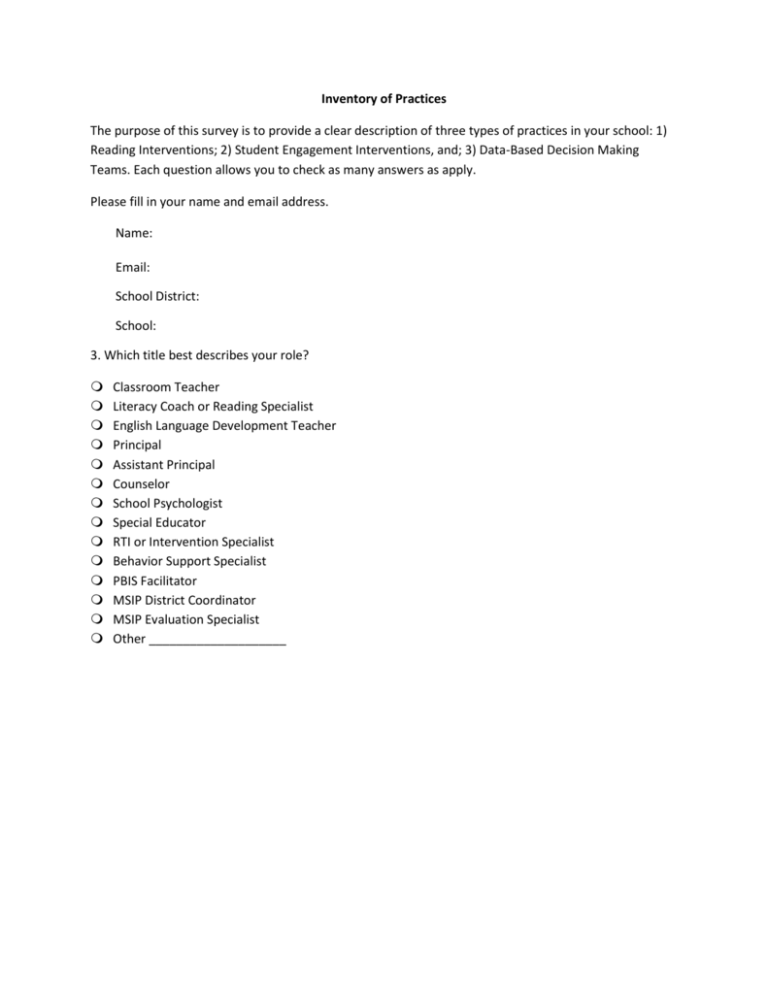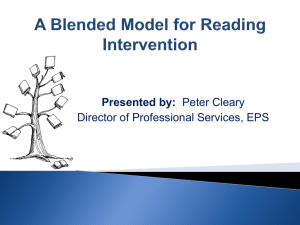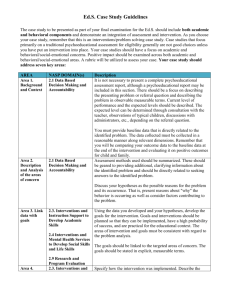Inventory_Of_Practic..
advertisement

Inventory of Practices The purpose of this survey is to provide a clear description of three types of practices in your school: 1) Reading Interventions; 2) Student Engagement Interventions, and; 3) Data-Based Decision Making Teams. Each question allows you to check as many answers as apply. Please fill in your name and email address. Name: Email: School District: School: 3. Which title best describes your role? Classroom Teacher Literacy Coach or Reading Specialist English Language Development Teacher Principal Assistant Principal Counselor School Psychologist Special Educator RTI or Intervention Specialist Behavior Support Specialist PBIS Facilitator MSIP District Coordinator MSIP Evaluation Specialist Other ____________________ Inventory of Practices: Reading Section Reading Assessment R1. How does your school assess the reading performance of all of the students in your school? (Check all that apply) OAKS - Reading Oral reading fluency measure(s) Other ____________________ Don't know Not applicable. Our school does not assess reading performance for all students in the school. Answer If R1. Reading assessments used “OAKS – Reading” Is Selected R1.1. Please indicate how frequently your school assesses the reading performance of all of the students in your school using OAKS. 1 x / year OAKS - Reading 2 x / year 3 or more x / year Varies based on student performance Answer If R1. Reading assessments used “Oral reading fluency measure(s)” Is Selected R1.2. Please choose or type the name of each oral reading fluency measure typically used to assess the reading performance of students in your school. 1 x / year 2 x / year 3 or more x / year Varies based on student performance AIMSWEB DIBELS EasyCBM Other ________ Other ________ Answer If R1. Reading assessments used “Other “Is Selected R1.3. You have indicated that your school uses a measure other than OAKS and oral reading fluency to typically assess the reading performance of students in your school. Please choose or type the name of any additional measures. Use the drop down menus to the right to indicate how frequently your school uses each assessment. 1 x / year 2 x / year 3 or more x / year Varies based on student performance In-Program Assessments EasyCBM MAZE Other Measure Other Measure R2. Does your school have a procedure for identifying students who need additional support in reading? No Yes Answer If R2. Procedure for identifying additional reading need “Yes” Is Selected R2.1 Which sources of information do you use to identify students who need additional reading support? OAKS reading score using a specified benchmark Oral reading fluency measure using a specified benchmark Teacher referral Special education eligibility assessment Parent request Diagnostic Assessment In-Program Assessment Other CBM Measures (other than ORF) Other (please describe below) ____________________ Don't know Reading Instruction R3. What type of reading instruction is typically provided to students in your school? (Check all that apply) Reading instruction is only provided to at-risk students (not all students) Language arts or reading classes Reading strategies are taught during content areas classes (e.g., social studies, science) Other (please describe) ___________________________________________________ Don't know Reading Intervention R4. Does your school use a published program(s)/curricula for students in reading interventions (rather than non-published or teacher-developed materials)? Yes No Answer If R4. Use published reading intervention programs “Yes” Is Selected R4.1. Please choose or list the names of all curricula/programs that are used for reading intervention classes/groups. Corrective Reading Horizons Language! Junior Great Books Phonics for Reading Prentice Hall Read Naturally Reading Advantage Reading Mastery Rewards Soar to Success Stars Other ____________________ Other ____________________ Other ____________________ Other ____________________ R4.1. If instructors have received training in the use of selected curriculum, specify the nature of that training. Mentoring/Coaching District-Provided Training School-Provided Training Consultant from Program Informal Training No Training Other ____________________ Unsure Answer If R4. Use published reading intervention programs “Yes” Is Selected R4.2. Does the school collect data and/or conduct observations to assess if the reading intervention is being implemented the way that it is intended by the publishers of the program? Yes, firmly in place Partially in place Plan to put in place during the next school year No, not aware of plans to put in place Don't know Progress Monitoring R5. Are regular progress monitoring assessments used to track the reading performance progress of students receiving reading intervention? Yes No Don't Know Answer If R5. Use progress monitoring to track reading performance “Yes” Is Selected R5.1. (part 1) Choose the types of progress monitoring assessments used to track the reading performance progress of students receiving intervention. AIMSWEB DIBELS EasyCBM In-Program Assessment MAZE OAKS Other Oral Reading Fluency (ORF) Teacher Observations Teacher Assessments Other ____________________ Other ____________________ R5.1. (part 2) For selected assessment, choose the frequency with which it is generally used. Daily Twice per week Weekly Bi-Weekly Monthly Other Don't Know R6. Additional comments on reading interventions: Inventory of Practices: Engagement Interventions Section STUDENT ENGAGEMENT INTERVENTIONS Student engagement interventions are options, available within the school, that support at-risk students who face academic, behavioral, or social challenges and that help build a stronger connection between the student and the school, staff, peers, and the learning process. These interventions may help students improve attendance, homework completion, and academic outcomes, or decrease the risk of eventual school drop-out. E2. What options for student engagement support are available to students in your school? If your school has options that are not listed, please use Options A, B, and C to enter up to 3 student engagement supports, providing very brief descriptions instead of names to help us understand the nature of the support. (Check all that apply) Check and Connect, Check-in/Check-out, or other similar programs Social Skills Group Newcomers' Group Friendship Group Girls' or Boys' Group Study Skills Group One-on-one tutoring or mentoring during the school day One-on-one counseling support Mentor Program Sports teams directly associated with the school (not club sports offered by private organizations) Leadership Group or Student Council Technology Club Drama Club Debate, Quiz Team Homework Club Band / Choir After School Clubs / Programs Chess Club Science and / or Math Teams Service Committees Option A _______________________________________________________________________ Option B _______________________________________________________________________ Option C _______________________________________________________________________ E3. Which options for student engagement that are available in your school utilize a process for meeting with an adult advocate or mentor at least once per month? _____________________________________________________________________________________ _____________________________________________________________________________________ _____________________________________________________________________________________ E4. Which options utilize students’ individualized goals as a focus of support? _____________________________________________________________________________________ _____________________________________________________________________________________ _____________________________________________________________________________________ E5. Is there an adult advocate (e.g., a teacher or educational assistant) assigned to each student in the student engagement intervention? (It can be the same advocate assigned to a group of students.) Yes For some students, but not all No Don't Know E6. How do students participating in student engagement options receive feedback on their progress? (Check all that apply) Feedback is given through the use of a daily or weekly point card that students carry from class to class Daily/weekly point information is sent home to encourage parents to provide feedback Teachers, special educators, and educational assistants give regular verbal feedback on progress Counselors, school psychologists, or other specialists give regular verbal feedback on progress Administrators or other individuals serving as mentors provide regular feedback Other ____________________ Don't know E7. How do students participating in student engagement options receive recognition and reinforcement for demonstrating significant improvement? (Check all that apply) Students use points, money, or credits to "purchase" items as part of a school-wide program Teachers, special educators, and educational assistants provide individualized reinforcers based on behavior contracts or student preferences Counselors, school psychologists, and other specialists provide individualized reinforcers based on behavior contracts or student preferences Administrators or others serving as mentors provide awards or other tokens of achievement as part of a school-wide program Parents are informed so they may provide reinforcers at home As part of a school-wide program, students earn privileges such as: _________________________ As part of a individualized program, students may earn privileges such as: ____________________ Other ____________________ Don't know E8. Which data are collected for students participating in student engagement options? (Check all that apply) Daily school attendance Student engagement intervention attendance or participation rate Indicator of academic progress (e.g., homework completion, points, grades, learning targets met) Number of office discipline referrals Number of in-school suspensions Number of tardies School staff reports based on observations Student self assessment Parent reports based on observations Check-In / Check-Out Points Other ____________________ Other ____________________ Don't know E9. Does the school collect data on the psychological engagement of students in the engagement interventions? Yes No Don't know Answer If E9. Are data collected on psychological engagement? “Yes” Is Selected E9.1. What kinds of psychological engagement data are collected? Student surveys Formal psychological assessment instruments Other ____________________ E10. Does the school collect data and/or conduct observations to assess if the student engagement or behavioral intervention is being implemented as intended? Yes, firmly in place Partially in place Plan to put in place during the next school year No, not aware of plans to put in place Don't know E11. Additional comments on student engagement interventions: Inventory of Practices: Data-Based Decision Making Section DATA-BASED DECISION MAKING TEAMS D1. Are there systems in place to collect and manage data regarding the academic achievement of all the students in your school (OAKS, grades, etc.)? Partially in place Yes, firmly in place Don't know Plan to put in place during the next school year No, not aware of plans to put in place Answer If D1. Use systems to manage academic data for all students “Yes, firmly in place” Is Selected Or D1. Use systems to manage academic data for all students “Partially in place” Is Selected D1.1 (Part 1). Please choose the school or district databases that your school uses to access data about the academic achievement of students. Data Warehouse DCA DIBELS (Dynamic Indicators of Basic Early Literacy Skills) EasyCBM eSIS (Student Information System) Excel OAKS (Oregon Assessment of Knowledge and Skills) SPA SWIS (School-Wide Information System) V-PORT Data Management Other ____________________ Other ____________________ Answer If D1.1 (Part 1). Please choose the school or district database Is Greater Than or Equal to 1 D1.1. (Part 2) Please select the types of information collected for selected databases Benchmark and Progress Monitoring Data Fluency Grades Oral Reading Fluency (ORF) Behavior Referrals Attendance Language! Comprehension and/or Vocabulary Data Reading Data Assessments and Scores Program Assignment Proficiency in Learning Targets State Scores/OAKS Additional Academic Information ____________________ Additional Behavior Information ____________________ Other __________________________________________ Don't Know Answer If D1.1 (Part 1). Please choose the school or district database Is Greater Than or Equal to 1 D1.1. (Part 3) Who requires the use of selected databases? District School District and School Other ____________________ Don't Know D2. Are there systems in place to collect and manage data regarding the students’ behavior and school engagement (e.g., attendance, tardies, office discipline referrals, etc.)? Partially in place Yes, firmly in place Don't know Plan to put in place during the next school year No, not aware of plans to put in place Answer If D2. Use systems to manage behavioral data for all students “Yes, firmly in place” Is Selected Or D2. Use systems to manage behavioral data for all students “Partially in place” Is Selected D2.1. (Part 1) Please choose the school or district databases that your school uses to access data about the behavior of students (e.g. attendance, office discipline referrals, etc.). Data Warehouse eSIS (Student Information System) Excel SPA SWIS (School-Wide Information System) DCA CICO Other ____________________ Other ____________________ Answer If D2.1. (Part 1) Please choose the school or district databases Is Greater Than or Equal to 1 D2.1. (Part 2) Please select the types of information collected for selected databases. Attendance Behavior Referrals Grades CICO Tardies Don't Know Additional Behavior Information ____________________ Additional Academic Information ____________________ Other __________________________________________ D2.1. (Part 3) Who requires the use of selected databases? District School District and School Other ____________________ Don't Know D3. Who meets to examine academic data on students participating in reading interventions at your school? Choose the response that most accurately captures the process. A team (Indicate the name of the team--and a very brief description, if helpful--below) ____________________ One or two Individuals Don't know There is no individual or group that examines data for this group of students The school plans to put a process in place in during the next school year If “There is no individual or group” Is Selected, Then Skip To End of Block. If “The school plans to put a process in place” Is Selected, Then Skip To End of Block. D3.1. Who regularly participates in these meetings? District Implementation Coordinator Principal Assistant Principal School Counselor School Psychologist Reading Specialist/Literacy Coach Instructor for Reading Intervention Groups Special Education Teacher Grade-level General Education Teacher ESL Teachers Student Teachers Other ____________________ There are no regular participants Don't Know D3.2. How often do these meetings take place? Weekly More than once a month, but less than once a week Once a month More than once a quarter (or trimester) but less than once a month Once a quarter (or once a trimester) Three times per year Less than 3 times per year Don't know D3.3 What data are regularly reviewed at these meetings? Curriculum -based progress monitoring data Oral reading fluency data Scores on OAKS assessments Progress toward individual goals Developmental history information Attendance Grades Office Discipline Referrals Suspensions/Expulsions Truancy Daily Behavior Progress Reports Anecdotal information about family functioning Anecdotal information about daily functioning in class Other ____________________ Don't know D4. Is there an additional team (or individual), other than the above-mentioned data-based decision making team, that meets to examine behavioral or student engagement data of students? No Yes, name(s) of other teams (and description, if helpful) ____________________ Don't know Answer If D4. “Yes, name(s) of other teams (and description, if helpful)” Is Selected D4.1. Who regularly participates in these additional meetings to examine behavioral or engagement data? District Implementation Coordinator Principal Assistant Principal School Counselor School Psychologist Reading Specialist/Literacy Coach Instructor for Reading Intervention Groups Special Education Teacher Grade-level General Education Teacher ESL Teachers Student Teachers Other ____________________ There are no regular participants. Don't Know Answer If D4. “Yes, name(s) of other teams (and description, if helpful)” Is Selected D4.2. How often does this additional team (or individual) meet to examine behavioral or engagement data? Weekly More than once a month, but less than once a week Once a month More than once a quarter (or trimester) but less than once a month Once a quarter (or once a trimester) Three times per year Less than 3 times per year Don't know D4.3. What data are regularly reviewed at these meetings that focus on behavioral or engagement data? Curriculum-based progress monitoring data Oral reading fluency data Scores on OAKS assessments Progress toward individual goals Developmental history information Attendance Grades Office Discipline Referrals Suspensions/Expulsions Truancy Daily Behavior Progress Reports Anecdotal information about family functioning Anecdotal information about daily functioning in class Other ____________________ Don't know D5. When the reading intervention data team (or individual) meets, is there a systematic process in place for reviewing data and making decisions about the progress of individual students who are experiencing reading problems? (For example, the data team may use pre-specified data sources to identify one reading program from a menu of options that will best match an individual student’s needs). Yes, firmly in place Partially in place Plan to put in place during the next school year No, not aware of plans to put in place Don't know Not applicable. There is no team (or individual) that examines students in reading intervention. D6. When the data team (or individual) reviews behavioral/engagement data, is there a systematic process in place for reviewing data and making decisions about the progress of individual students who are experiencing behavioral or school engagement problems? Yes, firmly in place Partially in place Plan to put in place during the next school year No, not aware of plans to put in place Don't know Not applicable. There is no team (or individual) that examines students' behavioral or engagement data. Q88 In your opinion, what does your school or district hope to gain from participation in this project? _____________________________________________________________________________________ _____________________________________________________________________________________ _____________________________________________________________________________________ Q90 Please provide any recommendations that we can use to improve this survey. _____________________________________________________________________________________ _____________________________________________________________________________________ _____________________________________________________________________________________ D10. Additional comments on data-based decision making in your school:





